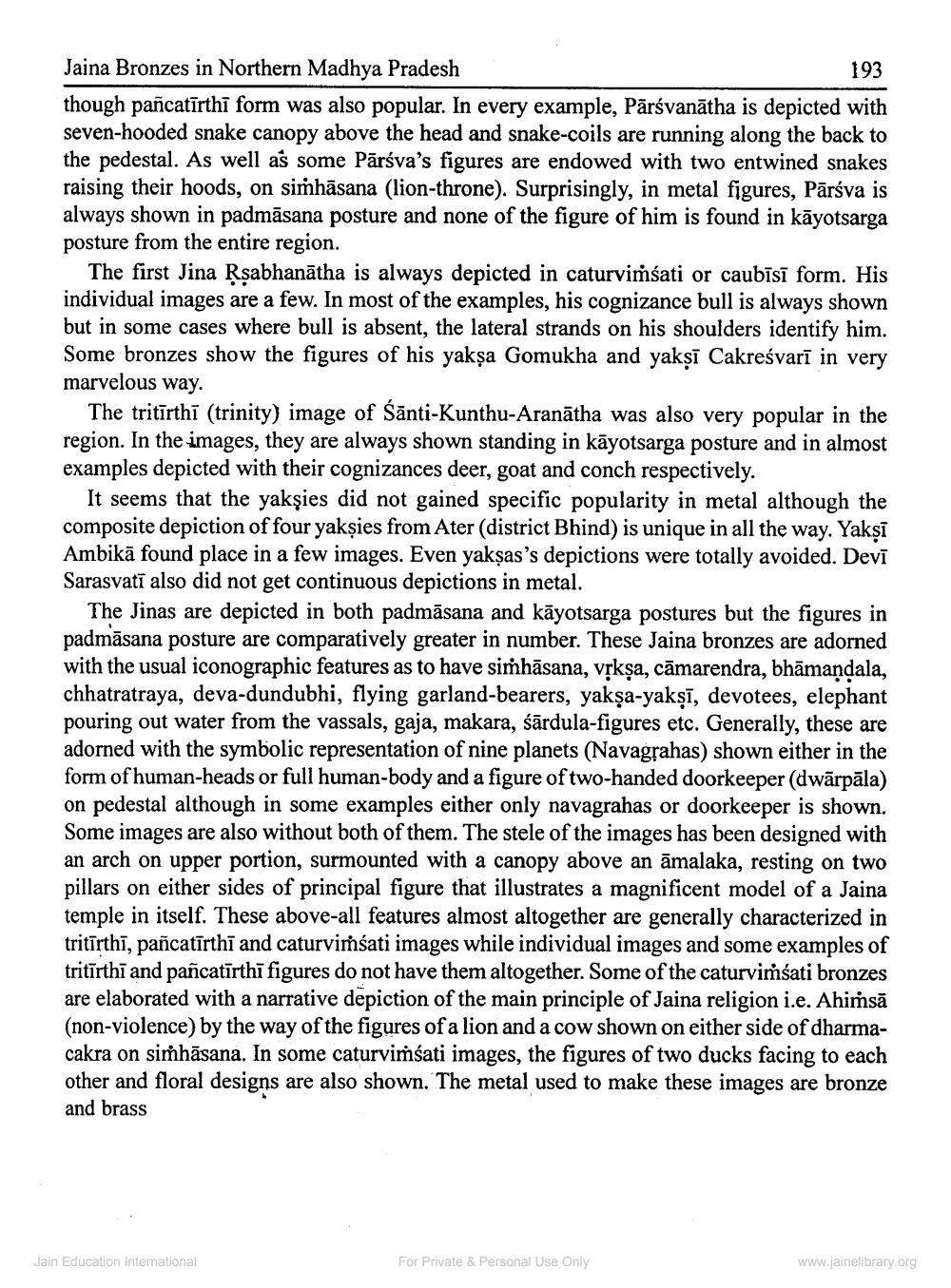________________
Jaina Bronzes in Northern Madhya Pradesh
193 though pañcatīrthĩ form was also popular. In every example, Pārsvanātha is depicted with seven-hooded snake canopy above the head and snake-coils are running along the back to the pedestal. As well as some Pārsva's figures are endowed with two entwined snakes raising their hoods, on simhāsana (lion-throne). Surprisingly, in metal figures, Pārsva is always shown in padmāsana posture and none of the figure of him is found in kāyotsarga posture from the entire region.
The first Jina Rsabhanātha is always depicted in caturviṁsati or caubīsī form. His individual images are a few. In most of the examples, his cognizance bull is always shown but in some cases where bull is absent, the lateral strands on his shoulders identify him. Some bronzes show the figures of his yakşa Gomukha and yaksī Cakreśvarī in very marvelous way.
The tritīrthī (trinity) image of Sānti-Kunthu-Aranātha was also very popular in the region. In the images, they are always shown standing in kāyotsarga posture and in almost examples depicted with their cognizances deer, goat and conch respectively.
It seems that the yakşies did not gained specific popularity in metal although the composite depiction of four yaksies from Ater (district Bhind) is unique in all the way. Yaksī Ambikā found place in a few images. Even yakşas's depictions were totally avoided. Devi Sarasvati also did not get continuous depictions in metal.
The Jinas are depicted in both padmāsana and kāyotsarga postures but the figures in padmāsana posture are comparatively greater in number. These Jaina bronzes are adorned with the usual iconographic features as to have siṁhāsana, vşkşa, cāmarendra, bhāmandala, chhatratraya, deva-dundubhi, flying garland-bearers, yakşa-yakṣī, devotees, elephant pouring out water from the vassals, gaja, makara, śārdula-figures etc. Generally, these are adorned with the symbolic representation of nine planets (Navagrahas) shown either in the form of human heads or full human body and a figure of two-handed doorkeeper (dwārpāla) on pedestal although in some examples either only navagrahas or doorkeeper is shown. Some images are also without both of them. The stele of the images has been designed with an arch on upper portion, surmounted with a canopy above an amalaka, resting on two pillars on either sides of principal figure that illustrates a magnificent model of a Jaina temple in itself. These above-all features almost altogether are generally characterized in tritīrthī, pañcatīrthi and caturvimšati images while individual images and some examples of tritīrthi and pañcatīrthī figures do not have them altogether. Some of the caturvimšati bronzes are elaborated with a narrative depiction of the main principle of Jaina religion i.e. Ahiṁsā (non-violence) by the way of the figures of a lion and a cow shown on either side of dharmacakra on siṁhāsana. In some caturviṁsati images, the figures of two ducks facing to each other and floral designs are also shown. The metal used to make these images are bronze and brass
Jain Education International
For Private & Personal Use Only
www.jainelibrary.org




